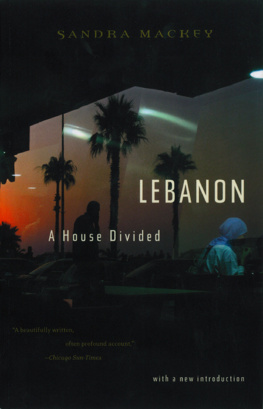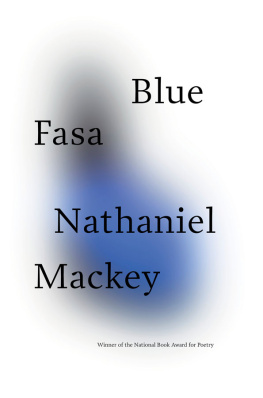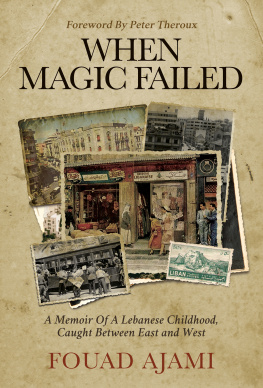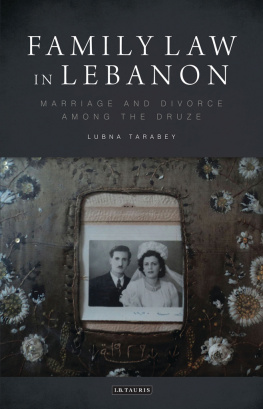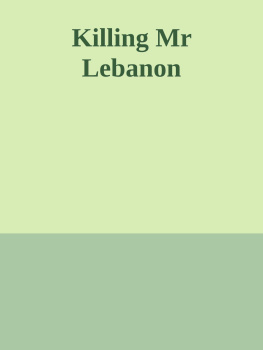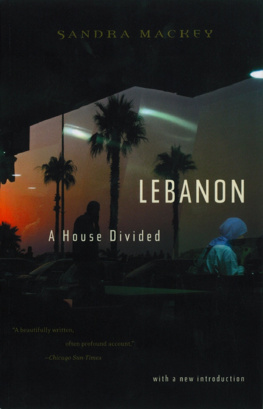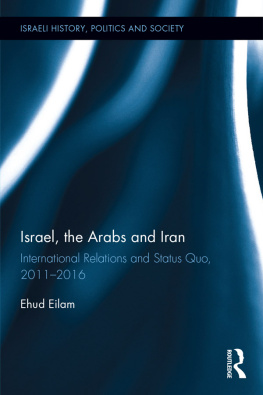
LEBANON
A House Divided
SANDRA MACKEY

W. W. Norton & Company
New York London
To Colin
Here am I, the wretched city, lying in ruins, my citizens dead... you who pass me by bewail my fate, and shed a tear in honour of Berytus that is no more.
Unknown sixth-century poet
T his book was originally published in 1989 under the title Lebanon: Death of a Nation. It was written during a time when Lebanon had entered the last stages of a brutal civil war that had ravaged civil society for almost fifteen years.
The violence was not confined to the Lebanese alone. The Palestinians were a part of the original conflict that erupted in 1975. Syria came in 1976 to take up the position of occupier. Israel, in pursuit of the Palestinians, invaded in 1978. Syria, to counter Israel, launched a second deployment in 1980. Israel marched to Beirut in 1982 and laid siege to the city, forcing Yassir Arafat and the PLO into an American-engineered exile.
In the carnage of that year U.S. Marines landed in Beirut as nave peacekeepers, only to be drawn into the conflict as combatants. The following year the United States lost 241 of its Marines to a new kind of warfare and a new enemycrude bombs delivered by trucks driven by Islamic militants. These Soldiers of God marched out of Lebanons Shiite community proclaiming the ideology of Ayatollah Khomeini and the Islamic revolution of Iran. By 1984, American troops had retreated from Lebanon in the ruins of failed U.S. policy. They left behind American civilians who became the targets of high-profile kidnappings that turned them into hostages to the militant Shiites demand that Lebanon be rid of its Western taint. In 1989, the Lebanese, exhausted by a war that had all but devoured the little country once known as the Switzerland of the East, negotiated a cease-fire to stop the killing.
The Taif agreement of October 1989 set the conditions on which the slaughter would end. But it did not rid Lebanon of the occupying forces of Israel and Syria, nor did it resolve the communal conflicts that lie at the root of the Lebanese state. The war did resolve the issue of Lebanons identity. Those who saw Lebanon as part of the West had been defeated by those who saw Lebanon as part of the Arab world. As a result, Lebanon took its place in the East, thereby closing the Wests wide gateway to the Arab world.
Why revisit Lebanon now? Conditions have both changed and stayed the same. Israel was forced out in 2000 by unacceptable casualty rates inflicted by Hizbollah. Syria withdrew in 2004 under intense Lebanese and international pressure. With the foreigners gone, the Lebanese now must find the formula that will turn a state composed of quarreling and vengeful communal groups into a nation. Thus at a time when the United States occupies Iraq and the West as a whole faces dangerous and serious security and economic threats from the Middle East, Lebanon serves as a case study of just how complex the social, political, and economic landscape of the Middle East really is.
In a forthcoming second volume, the story of Lebanon will continue to be told for the same reason that this book has been reprinted. Although distinctly and profoundly different from other Arab countries, Lebanon shares many of the same challenges present in other states in a region in which benign breezes and vicious winds of change are blowing. The Lebanese, like their neighbors, are entangled in a web created by the presence of intensively cohesive communal groups that complicate the basic definition of the state; by questions regarding the distribution of economic resources; by a young population that is laying siege to the old elites; by the conflict between Israel and the Palestinians; by militant Islam, which has turned religion into a political ideology; by the meddling of Iran; by the rising contest between Shiites and Sunnis; and by the presence of the United States in Iraq. This is why this tiny country on the edge of the Mediterranean is demanding attention and contemplation by the Western world. Even though the societal components and cultural specifics are vastly different, Lebanonin its tangled skein of families, tribes, rivalries, challenges, resentments, and competing identitiesis, in important respects, Syria, Jordan, Egypt, Saudi Arabia and, especially, Iraq.
W hen using a limited number of words to write about a subject as complex as Lebanon it is critical to establish exactly what the author intends to accomplish. This is not a history of the Lebanese civil war. I feel that task is better left to the historians. Rather, this book explores the agonizing divisions within Lebanon between its Arab soul and its Western veneer. In approaching the war in this manner, I seek to explain to nonspecialist Western readers why the Lebanon of the 1960s and early 1970s, which they perceived as a magical playground proudly touting its Western ways, is now a caldron of ugly hostilities that have effectively sealed off the country from Westerners. Thus the narrative emphasizes those conditions and events that have contributed to the anti-Western aspect of the war.
In this context, I emphasize Israels treachery in Lebanon more than Syrias, because Israel is central to the Arabs virulent anti-Western passions. The wartime role of the Soviet Union as an arms supplier to various Muslim forces has only been touched on since its impact on Arab perceptions of the West is minor. I have chosen to discuss only a select number from the galaxy of men who competed with each other within the communal politics of prewar Lebanon. Each of these men represents the attitudes of a faction or a confessional about Lebanons place in the Arab world. Other factors that play an important part in the carnage in Lebanon are similarly treated within the context of Lebanons cultural divisions.
One further note. The transliteration of Arabic to English is problematic at best. There is no standard system recognized for either academic or general audiences. Since no method of transliteration is without its critics, I have chosen to use the simplified forms of Arabic words, names, and locations commonly used by newspapers in the United States. The diacritical marks, glotal stops, consonant sounds unique to Arabic, and marks for long vowels have been omitted. Quotations from other writers are retained in their original form.
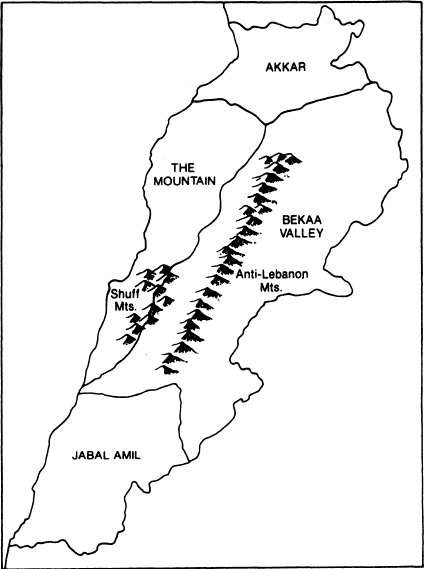
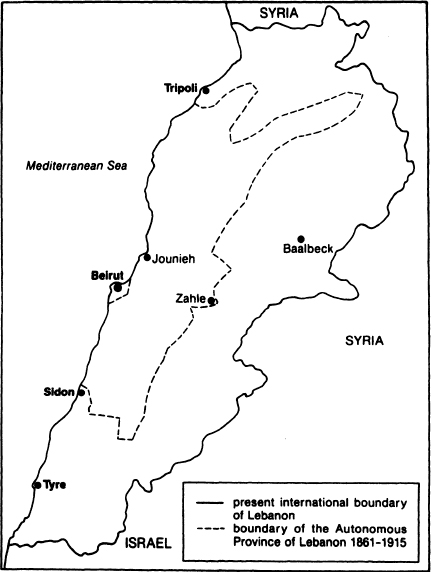
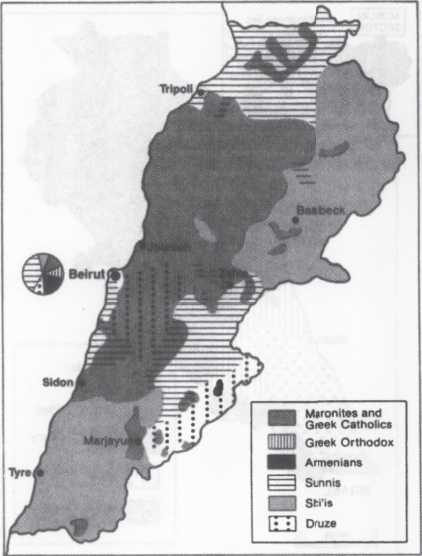
Source: Itamar Rabinovich, The War for Lebanon, 19701985, rev. ed. (Ithaca, N. Y.: Cornell University Press, 1985), 23.
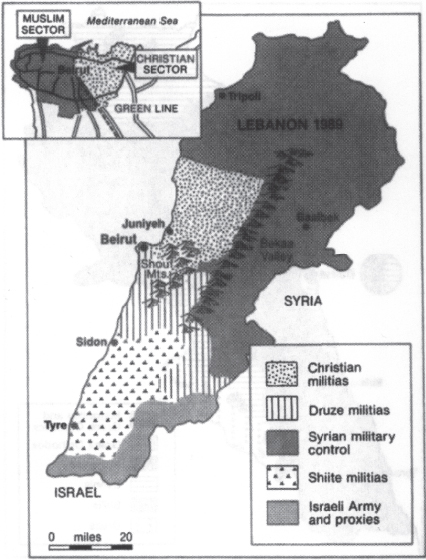
Source: Based on a map by Joan Forbes in the Christian Science Monitor. 1988 TCSPS
| 1861 | The Mountain declared an autonomous province within the Ottoman Empire. |
| 1920, August 31 | Establishment of Greater Lebanon under the French Mandate. |
| 1943 | The National Pact. |
| 1946 | Final withdrawal of French forces, leading to an independent Lebanese republic; Bishara Khoury elected president. |
Next page
